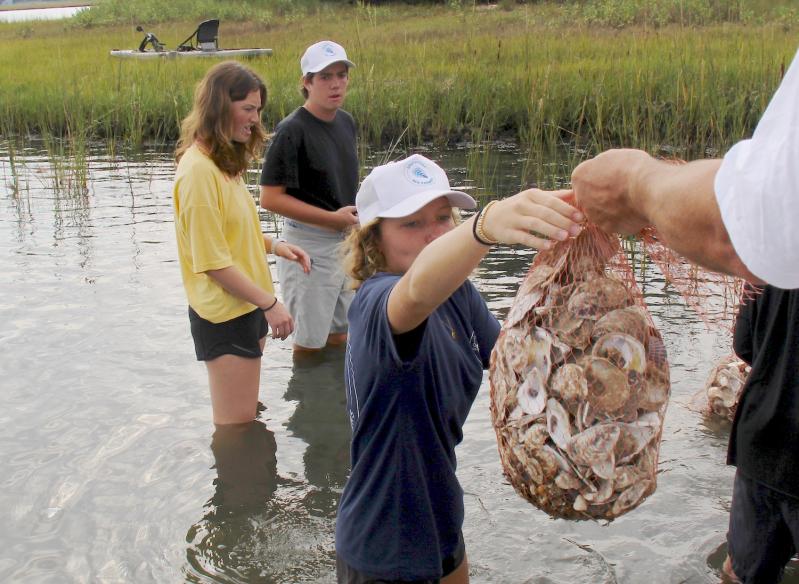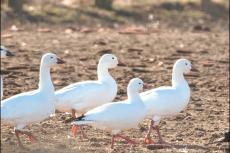The director of East Hampton Town’s Aquaculture Department updated the town board as to its activities and future plans on Tuesday, and two East Hampton High School students provided an update on a South Fork Sea Farmers’ pilot project, a recently constructed oyster reef in Accabonac Harbor.
Barley Dunne told the board that the Aquaculture Department has seeded local waters with around 2.5 million 40-millimeter oysters, “a really beautiful crop this year,” along with around 7 million 10-millimeter clams. “Again, that’s a really great crop for one year,” he said. The town will also contribute 300,000 clams and about 180,000 spat-on-shell oysters to the Long Island Shellfish Restoration Project, which Mr. Dunne said are likely bound for Hempstead Bay.
The news was not as positive for bay scallops. Though it is unrelated to the near-total die-off of the delicacy in each of the last few years, the Aquaculture Department was able to seed only around 50,000 scallops, Mr. Dunne said, far short of the 300,000 to 400,000 seeded in the two prior years. “This year, for some reason, they made it through the hatchery really well,” he said, but “we got them to the nursery and they slowly died off.”
The town’s community oyster-gardening program has grown from around 15 participants to 100, with six residents growing oysters from their own docks. The program will conclude this weekend, after which oyster cages will be sunk to the bottom until it resumes in the spring.
A pilot program begun last winter, the growing of 100-foot lines of sugar kelp in Three Mile and Accabonac Harbors, experienced some growing pains, Mr. Dunne said, but a part of Accabonac Harbor off Shipyard Lane in Springs “was a great producer,” with “nice, long blades” of kelp. Leftover sporophytes, or baby kelp blades, were “tossed off our dock at the nursery,” he said, “and grew like crazy.”
The program’s purpose is to extract nitrogen, carbon, and phosphorous in order to improve the quality of impaired water bodies. One of the fastest growing plants in the world, kelp not only takes in five times more carbon than most plants on land, but sequesters more carbon than eelgrass, mangroves, and salt marshes combined, based on biomass. This counters oceanic acidification, which results from the absorption of carbon dioxide from greenhouse gas emissions.
Kelp also serves as habitat for juvenile shellfish and finfish. When removed from the water, it can be used as food for human consumption, as animal feed, as fertilizer, and as biofuel.
The oyster and kelp growing seasons are complementary; the former is ending now, and the latter beginning. “We spawn kelp in October-November, it grows through the winter, and is harvested in May,” Mr. Dunne told the board. “It works well scheduling-wise, which is why New York wants to bring it in as an alternative crop.”
The site in Three Mile Harbor will be abandoned, he said, after the disappointing results, but lines will again be deployed off Shipyard Lane and in deeper water offshore.
Skye Tanzmann and Nick Cooper, the high school students and South Fork Sea Farmers interns, told the board that a “huge problem with excessive E. coli” bacteria and eutrophication in Accabonac Harbor led to the 50-yard-long oyster reef that was installed last month with the help of Springs School sixth graders.
Oysters can filter up to 50 gallons of water per day, Skye told the board. “An entire reef of them would have a great environmental impact on improving the pollutant-free water column that we hope to achieve.”
Another benefit of oyster reefs, Nick said, is that they can prevent erosion and potentially reclaim land by absorbing and reflecting waves, reducing their impact on the shoreline.
Last month’s installation of spat-on-shell oysters in biodegradable bags was a success, and Skye and Nick hope to oversee the creation of two more oyster reefs. One, pending the property owner’s approval, could be in the waters off 113 Louse Point Road in Amagansett, where Nick said there is “a significant erosion problem.” At the other potential site, she said, off 104 Gerard Drive in Springs, a similar erosion problem exists.




